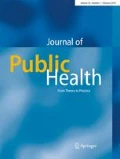Abstract
Self-help groups have found increasing recognition by health professionals in recent years. However, considerable research deficits remain, particularly regarding self-help groups for persons with psychiatric and psychosomatic disorders. We present a survey on the dissemination and differentiation of such groups in Germany and their support by self-help advice centres. Most likely, more than 5,000 of these groups exist covering a broad range of psychiatric disorders, particularly groups for families and partners, bereavement, anxiety disorders, depression, and eating disorders. These groups are supported by self-help advice centres in various ways from information to group counselling in difficult periods. The results of the survey encourage further in depth study of self-help groups, their cooperation with psychotherapists, and their health promoting potentials.
Similar content being viewed by others
References
Badura B, Schaeffer D, v. Troschke J (2001) Versorgungsforschung in Deutschland—Fragestellungen und Förderbedarf. Z Gesundheitswiss 9:294–311
Borgetto B (2003) Gesundheitsbezogene Selbsthilfe in Deutschland—Stand der Forschung. Nomos Verlagsgesellschaft, Baden Baden
Braun J, Kettler U, Becker I (1997) Selbsthilfe und Selbsthilfeunterstützung in der Bundesrepublik Deutschland. Kohlhammer, Stuttgart
Daum KW (1984) Selbsthilfegruppen. Eine empirische Untersuchung von Gesprächs-Selbsthilfegruppen. Psychiatrie-Verlag, Rehburg-Loccum
Daum KW, Matzat J, Moeller ML (1984) Psychologisch-therapeutische Selbsthilfegruppen. Ein Forschungsbericht. Schriftenreihe des Bundesministers für Jugend, Familie und Gesundheit. Kohlhammer, Stuttgart
Deutsche Arbeitsgemeinschaft Selbsthilfegruppen (2001) Selbsthilfekontaktstellen. Empfehlungen der Deutschen Arbeitsgemeinschaft Selbsthilfegruppen e.V. zu Ausstattung, Aufgabenbereichen und Arbeitsinstrumenten. Selbsthilfegruppenjahrbuch 2001, pp 167–174
Emrick CD, Tonigan JS, Montgomery H, Little L (1993) Alcoholics Anonymous: what is currently known? In: McCrady BS, Miller WR (Ed) Research on Alcoholics Anonymous—opportunities and alternatives. Rutgers Center of Alcohol Studies, New Brunswick, pp 41–76
Engelhardt HD, Simeth A, Stark W (1995) Was Selbsthilfe leistet. Ökonomische Wirkungen und sozialpolitische Bewertung. Lambertus, Freiburg
Fichter M, Cebulla M (2001) Selbsthilfeorganisationen und -gruppen in der Verhaltensmedizin: Übersicht und Beschreibung. Verhaltenstherapie 11:144–165
Grunow D (1998) Selbsthilfe. In: Hurrelmann K, Laaser U (eds) Handbuch Gesundheitswissenschaften. Juventa, Weinheim, pp 683–703
Hüllinghorst R (2001) Selbsthilfegruppen für Suchtkranke: Zwischen allen Stühlen? Selbsthilfegruppenjahrbuch :53–61
Kettler U, Becker I (1997) Selbsthilfeförderung in der Bundesrepublik Deutschland. NDV (Heft 5) 152–155
Kyrouz EM, Humphreys K (2003) A review of research on the effectiveness of self-help mutual aid groups. http://www.mentalhelp.net/poc/view_doc.php/type/doc/id/993
Matzat J (1999) Kontaktstelle für Selbsthilfegruppen. Professionelle Hilfe zur Selbsthilfe. In: Günther P, Rohrmann E (eds) Soziale Selbsthilfe: Alternative, Ergänzung oder Methode sozialer Arbeit? Universitätsverlag C. Winter, Heidelberg, pp 205–217
Matzat J (2002a) Die Selbsthilfe als Korrektiv und ‘vierte Säule’ im Gesundheitswesen. Forschungsjournal Neue Soziale Bewegung 3:89–97
Matzat J (2002b) The development of self-help groups and support for them in Germany. Int J Self Help Self Care 1:307–322
Matzat J (2003) Bürgerschaftliches Engagement im Gesundheitswesen—unter besonderer Berücksichtigung der Patienten-Selbsthilfebewegung. In: Enquête-Kommission “Zukunft des Bürgerschaftlichen Engagements”, Deutscher Bundestag (ed) Bürgerschaftliches Engagement und Sozialstaat. Leske + Budrich, Opladen, pp 289–331
Matzat J, Spangenberg N (1989) Selbsthilfegruppen in der Nachsorge nach stationärer psychotherapeutischer Behandlung. In: Söllner W et al. (eds) Sozio-psycho-somatik. Springer, Berlin, pp 343–354
Moeller ML (1992) Anders Helfen–Selbsthilfegruppen und Fachleute arbeiten zusammen. Fischer, Frankfurt/Main
Moeller ML (1996) Selbsthilfegruppen–Anleitungen und Hintergründe. Rowohlt, Reinbek
Stübinger D (1977) Psychotherapeutische Selbsthilfegruppen in der BRD. Med. Dissertation, Gießen
Troschke J v (ed) (2001) Public Health—Entwicklung und Potentiale. Z Gesundheitswiss 4: Beiheft
Acknowledgement
We would like to thank our colleagues in the self-help advice centres for supporting our study with great commitment.
Author information
Authors and Affiliations
Corresponding author
Additional information
Funded by BKK Bundesverband, project grant “Self-help groups for psychiatric and psychosomatic disorders”.
Rights and permissions
About this article
Cite this article
Meyer, F., Matzat, J., Höflich, A. et al. Self-help groups for psychiatric and psychosomatic disorders in Germany—themes, frequency and support by self-help advice centres. J Public Health 12, 359–364 (2004). https://doi.org/10.1007/s10389-004-0071-0
Received:
Accepted:
Published:
Issue Date:
DOI: https://doi.org/10.1007/s10389-004-0071-0



